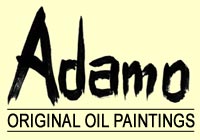|
|
|
Some Notes on Art: Its Purposes and Methods. Adamo has been painting for more than six decades. Writers have noted that he “uses the techniques of classical Italian painters” and all have commented upon the fact that his “paintings have a luminescence” rarely seen in artworks today. In the comments below, Adamo speaks about his approaches to painting. I agree with artist and critic John Ruskin, who maintains that works of art should be beautiful. Beauty entices the viewer to enter the peaceful, unthreatening environment of the artwork. |
|
Artists have attempted to create beauty in both non-objective and objective artworks. Artists who create non-objective works avoid recognizable objects and focus solely on the academically understood and formulated syntaxes of color and contrast to produce beauty. Artists who create objective works add objects found in the world around us to their syntaxes of color and contrast to produce beauty. Objective painters understand that realism and abstraction differ not in kind but in degree. These artists portray objects in their works somewhere along the abstraction/realism scale—to some degree more or less abstracted or to some degree more or less realistic. |
|
I am an oil painter. I produce objective artworks. Lastly, I am a realist painter. Like other objective artists, I present my ‘objects’ subjectively. That is, my understanding of the world is drawn from my interactions with the world. One may refer to these attitudes or viewpoints which comprise tone in my pieces as the content of my work. All artists are—to some degree—attempting to manipulate the mind of the viewer, objective artists more so than non-objective artists. |
|




